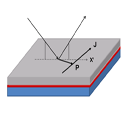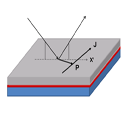Current Flow While in Equilibrium
When circularly polarized light shines on a semiconductor, it creates a population of polarized carriers, which in turn induce a dc electric current, an effect known as the circular photogalvanic effect (CPE). In order for this effect to take place, the light beam must be able to create a nonequilibrium distribution of carriers. For this reason, CPE does not take place in bulk semiconductors if the energy of the photons is less than the semiconductor energy gap. In superconductors, however, a flow of electrons might be created by spatial phase variations in the wave function, analogous to the Meissner effect, while the system is in thermal equilibrium.
Writing in Physical Review Letters, Anatoly Mal’shukov of the Russian Academy of Science in Troitsk proposes that in a hybrid superconductor-semiconductor system, CPE should be observable even without driving the system out of thermal equilibrium. The model system consists of a semiconductor and superconductor layer, with a doped quantum well between them. The semiconductor is thus subject to both illumination and proximity-induced superconducting coherence effects. The resulting Cooper pair correlations induced in the semiconductor yield a dc current, which, unlike in a pure semiconductor, is not due to a shift of the electron distribution from the thermal equilibrium. The proposed effect has implications not only for spintronics but also for topological superconductors, since the setup studied has been considered as a key element in recent studies of these. – Daniel Ucko





